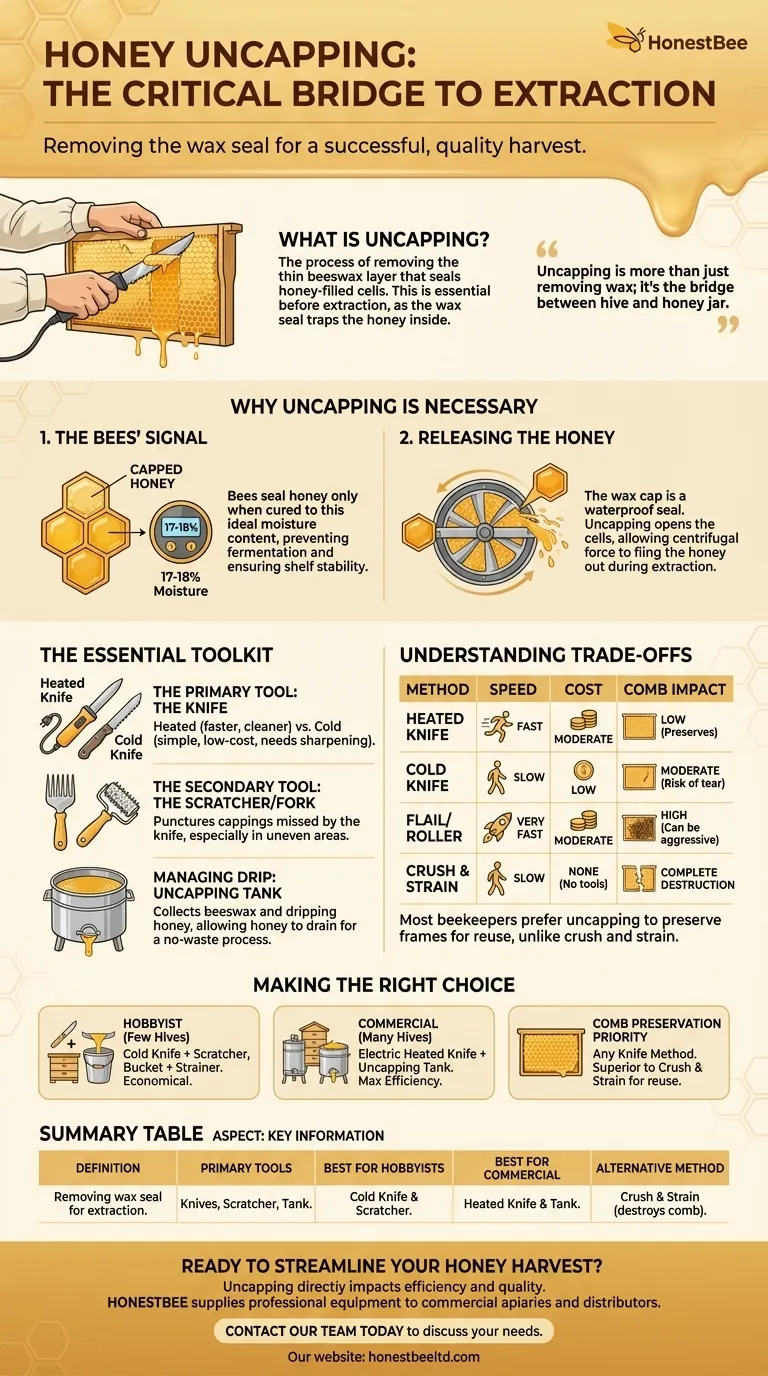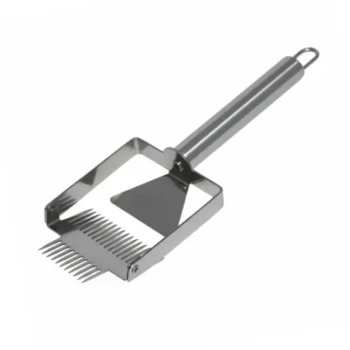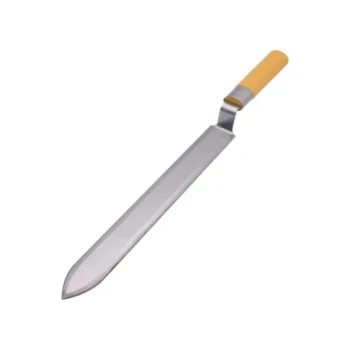In beekeeping, uncapping is the process of removing the thin beeswax layer that honey bees build to seal their honey-filled cells. This is an essential step that must be performed before extraction, as the wax seal traps the honey inside the comb. Without uncapping, the honey cannot be removed.
Uncapping is more than just removing wax; it is the critical bridge between the hive and the honey jar. It's performed only after bees have "capped" the honey, their signal that it has reached the ideal moisture content, ensuring the final product is stable and of the highest quality.

Why Uncapping is a Necessary Step
Before honey can be extracted, the protective wax seal placed by the bees must be broken. This seal serves a vital purpose in the hive, and removing it is the key to a successful harvest.
The Bees' Signal: What Capped Honey Means
Bees are meticulous. They only seal a cell of honey with a wax capping once the honey has been "cured" to the correct moisture content, typically around 17-18%.
This low moisture level is crucial because it prevents the honey from fermenting, making it shelf-stable almost indefinitely. Capped honey is the bees' signal that the honey is ready for long-term storage—and for harvesting.
Releasing the Honey for Extraction
The wax cap is a perfect, waterproof seal. While this is ideal for storage inside the hive, it means the honey is completely trapped within the comb's hexagonal cells.
Most extraction methods use centrifugal force, spinning the frames inside a machine called an extractor. This force flings the honey out of the cells, but it only works if the cells are open. Uncapping provides that opening.
The Essential Toolkit for Uncapping
While a vast array of beekeeping equipment exists, only a few key tools are needed for the uncapping process itself.
The Primary Uncapping Tool: The Knife
An uncapping knife is used to slice off the top layer of wax cappings. These come in two main varieties:
- Heated Knife: An electric knife that heats up, allowing it to melt through the wax for a faster, cleaner cut.
- Cold Knife: A simple serrated knife that is often dipped in hot water between passes to help it slice through the wax more easily.
The Secondary Tool: The Scratcher or Fork
A knife cannot always uncap every cell, especially in frames with uneven or recessed areas of comb.
An uncapping scratcher or fork is a comb-like tool with sharp tines used to puncture the cappings of any cells the knife missed. A roller with plastic spikes serves a similar purpose and can be faster for some beekeepers.
Managing the Cappings and Honey Drip
When you uncap a frame, you get a mixture of beeswax cappings and a significant amount of dripping honey.
This mixture is typically collected in an uncapping tank or a simple food-grade bucket fitted with a sieve. This setup allows the honey to drain away from the wax cappings, ensuring that neither goes to waste. The collected wax is highly valued for making candles, balms, and other products.
Understanding the Trade-offs
The method you choose for uncapping involves balancing speed, cost, and the impact on your equipment.
The Heated Knife: Speed vs. Cost
A heated knife is the preferred tool for beekeepers with many hives. It glides through the wax, dramatically speeding up the process. The main drawbacks are its higher cost and the need for a power source.
The Cold Knife: Simplicity vs. Effort
A cold knife is inexpensive and simple, making it a great starting point for hobbyists. However, it is slower than a heated knife and may be more likely to tear the comb if it is not kept sharp and clean.
The Flail or Roller: Fast but Potentially Destructive
Uncapping flails or rollers can clear a frame very quickly. However, they can be more aggressive on the comb structure and may incorporate more air into the honey, which can be a minor issue during bottling.
Extraction Without Uncapping: Crush and Strain
It's important to recognize that uncapping is only necessary for centrifugal extraction. An alternative method, "crush and strain," involves mashing up the entire comb and straining the honey out.
This method requires no uncapping tools but completely destroys the comb. Since bees expend enormous energy to produce wax and draw out comb, most beekeepers prefer to uncap and preserve the frames for reuse.
Making the Right Choice for Your Goal
Your choice of uncapping tools should align with the scale of your beekeeping operation and your primary goals.
- If you are a hobbyist with just a few hives: A simple cold knife and an uncapping scratcher, used over a food-grade bucket and strainer, are perfectly effective and economical.
- If you are managing a larger number of hives: Investing in an electric uncapping knife and a dedicated uncapping tank will significantly speed up your workflow and improve efficiency.
- If your priority is preserving the drawn-out comb: Any knife-based uncapping method is superior to "crush and strain," as it allows you to return the empty frames to the bees for a head start on the next season.
Ultimately, mastering uncapping is about working cleanly and efficiently to honor the bees' hard work and harvest beautiful, high-quality honey.
Summary Table:
| Aspect | Key Information |
|---|---|
| Definition | Removing the beeswax seal from honey-filled comb cells to allow extraction. |
| Primary Tools | Heated/Cold Knife, Uncapping Scratcher/Fork, Uncapping Tank. |
| Best For Hobbyists | Cold knife and scratcher; economical for a few hives. |
| Best For Commercial | Electric heated knife and uncapping tank; maximizes efficiency. |
| Alternative Method | Crush and Strain (destroys comb, no uncapping tools needed). |
Ready to Streamline Your Honey Harvest?
Uncapping is a critical step that directly impacts your harvest's efficiency and honey quality. Using the right professional equipment ensures a smooth, clean process that preserves your valuable comb.
HONESTBEE supplies durable, high-performance beekeeping supplies and equipment—including uncapping knives, tanks, and extractors—to commercial apiaries and beekeeping equipment distributors through our wholesale-focused operations.
Let us help you equip your operation for success. Contact our team today to discuss your specific needs and discover how our products can enhance your productivity and honey yield.
Visual Guide

Related Products
- All Stainless Steel Double Sided Pivoting Honey Uncapping Fork
- Adjustable Stainless Steel Honey Uncapping Fork with Scraper for Beekeeping
- Professional Stainless Steel Double-Sided Honey Uncapping Knife
- Professional Honey Uncapping Roller for Efficient Harvesting
- Professional Compact Multi-Function Uncapping Knife for Beekeeping
People Also Ask
- What is the recommended practice when using plain knives for uncapping? Master the Two-Knife Method for a Perfect Harvest
- What are the common methods used by small-scale beekeepers to uncap honey frames?
- What is the first step in the honey extraction process? Master the Critical Art of Uncapping
- What to use to uncap honey? Choose the Right Tool for Your Apiary
- What is the use of an uncapping fork? A Precision Tool for Hive Management and Honey Harvesting



















